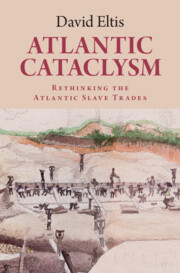Book contents
- Atlantic Cataclysm
- Atlantic Cataclysm
- Copyright page
- Epigraph
- Dedication
- Contents
- Figures
- Tables
- Maps
- Preface
- Acknowledgements
- Abbreviations
- 1 Atlantic Slave Trading and World History
- 2 The Americas and Atlantic Slave Trading: The Iberians and the Rest
- 3 Europe and Atlantic Slave Trading
- 4 The Portuguese System
- 5 Africa, Africans, and the Slave Trade
- 6 Abolition: A Leninist Interpretation
- 7 Freedom?
- Conclusion
- Index
2 - The Americas and Atlantic Slave Trading: The Iberians and the Rest
Published online by Cambridge University Press: 13 December 2024
- Atlantic Cataclysm
- Atlantic Cataclysm
- Copyright page
- Epigraph
- Dedication
- Contents
- Figures
- Tables
- Maps
- Preface
- Acknowledgements
- Abbreviations
- 1 Atlantic Slave Trading and World History
- 2 The Americas and Atlantic Slave Trading: The Iberians and the Rest
- 3 Europe and Atlantic Slave Trading
- 4 The Portuguese System
- 5 Africa, Africans, and the Slave Trade
- 6 Abolition: A Leninist Interpretation
- 7 Freedom?
- Conclusion
- Index
Summary
The Spanish and Portuguese and their American territories saw the disembarkation of almost two-thirds of all the enslaved carried from Africa. They were the first colonizers of the Atlantic and chose those areas that were best for obtaining slaves and putting them to work in the Americas. Almost every port large enough to launch a transoceanic voyage at some point entered the slave trade. Rio de Janeiro and Bahia (now Salvador) dispatched more vessels to Africa than did any European port, and overall sent out more voyages than did Europe. Thus the typical slave-trading voyage was not triangular, but rather bilateral. The Americas were the center of the slave trade because of their millennia-long isolation from the rest of the world, the inability of their Indigenous populations to resist Old World pathogens, and the very high land–labor ratios that resulted. Voyages to Africa from the Americas were quicker than those from Europe and the plantations and mines quickly generated a pool of investors willing to underpin the slave trade. In Brazil, especially, these small investors included free and enslaved Blacks, including even some enslaved crew. Close to half the merchandise traded for slaves came to be produced in the Americas rather than in Europe.
Keywords
- Type
- Chapter
- Information
- Atlantic CataclysmRethinking the Atlantic Slave Trades, pp. 46 - 100Publisher: Cambridge University PressPrint publication year: 2025

